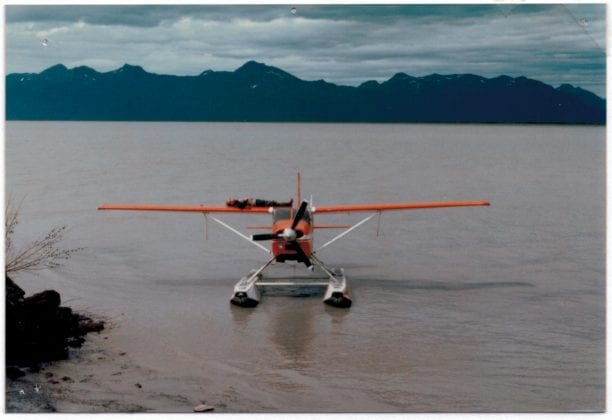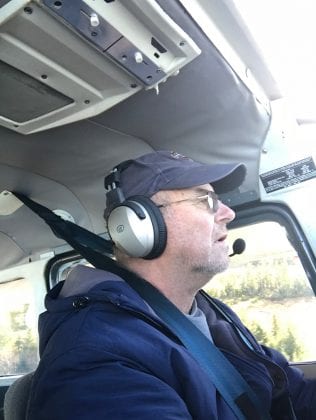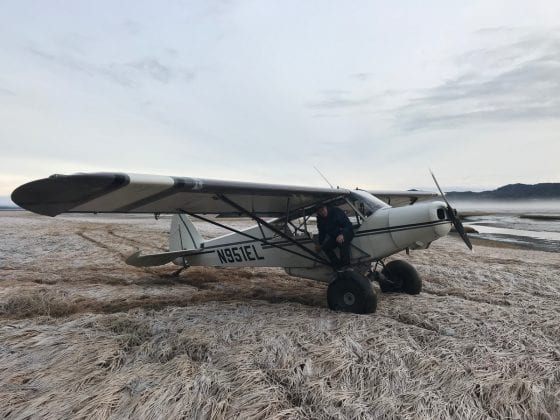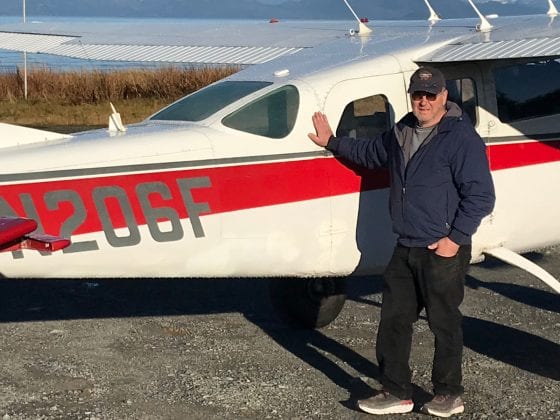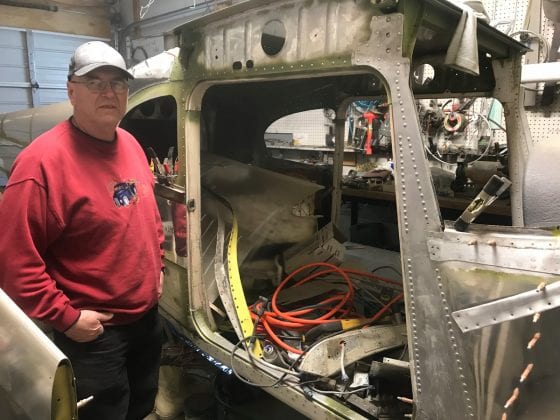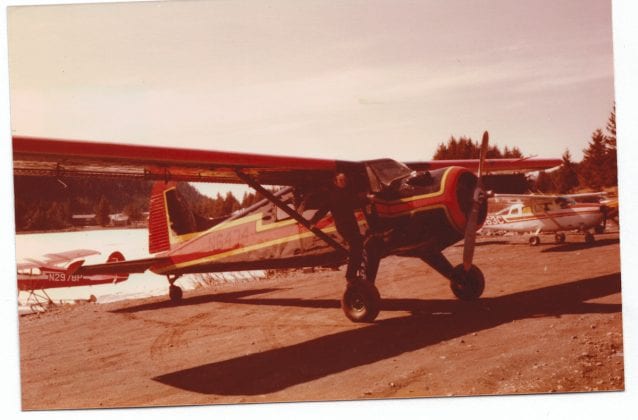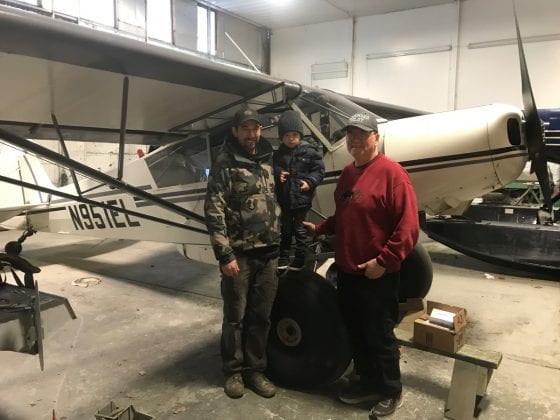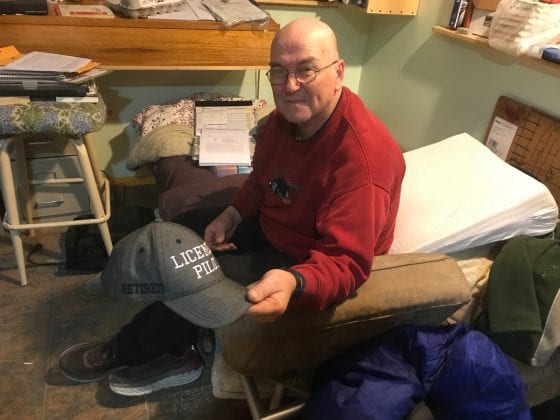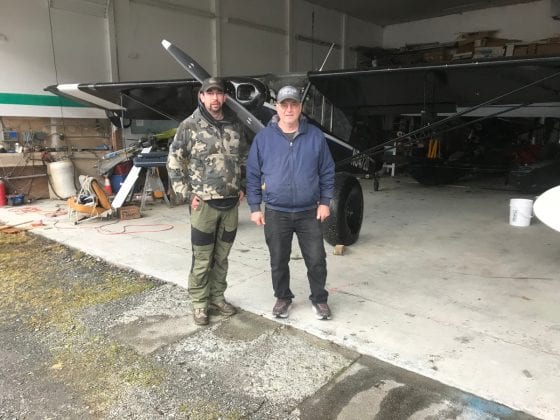Terry Kennedy made his last commercial flight on Oct. 31, 2018, ending a remarkable 50-year career flying small planes in Alaska’s challenging conditions.
Kennedy plans on continuing his love affair with air as a flight instructor, and perhaps as an author. He certainly is not about to distance himself from planes; and in fact, lives in a small apartment directly above a trio of Super Cubs parked in his hangar near the small airport beside Eyak Lake, “right in his work”, according to his daughter, Andrea Kennedy Whitcomb.
I’ve known Terry for years, and have flown with him several times, as have many Cordovans. He lives for flying, and it should come as no surprise, that when I stopped by to shoot the breeze, he directed me to sit in a repaired pilot’s seat right in the middle of his crowded apartment, while he shared wisdom and tales of an airborne lifetime.
Kennedy is quiet, soft-spoken, and modest; and it is his sense of humor and humility that stand out once you get him flying verbally, so to speak.
Why, he even found a small cardboard parts-card stacked in a pile of papers on top of a filing cabinet that contained on its back a list of titles for his favorite flying stories. Believe me, if he ever writes a book, it will soar off the shelves.
Kennedy was born in Pennsylvania in 1947, and his family moved to Valdez when he was 4 years old. His dad was a mechanic turned pilot that was in love with planes and flying, and by age 14, son Terry was already at the controls of a small plane and soloed when 16. He graduated from Valdez High, served in Vietnam in 1967-78 as a helicopter mechanic, and picked up his commercial license at age 21 while finishing his three-year stint in the Army while stationed in Fairbanks.
Kennedy earned his air-frame license in 1970, and first came to Cordova in 1971 to work for Wayne Smith at Chitina Air. Right after he arrived, one of Wayne’s pilots left, so Kennedy soon found himself doing a lot more flying than mechanical work.
Kennedy named many pilots that taught him skills that kept him airborne and accident free for 50 years, and he listed Smith as among the best. Lesson #1 was safety. “Fly the plane first” was one of Wayne’s sayings”, said Kennedy, referring to the constant pressure to go airborne in marginal conditions from a vast array of clientele that included hunters, loggers, and both sport and commercial fisherman.
“The hardest thing to learn in flying is when to say no”, said Kennedy, whose father Robert told him that “making your career accident free” should be the ultimate goal.
Location, weather, and people always factored in, and Kennedy described how, especially early in his career, he had lessons to learn.
“When I first came to Cordova, we had the mail contract, which meant flying parcels to Cape Yagataga and other small places. I would hurry up to the post office to try to get the mail, so I could then hustle back and fly it out”, said Kennedy. “One time I got very rude to Hollis Henrich and his wife, who were working at the post office at that time, about not having the mail out quickly.”
The next day he went back and apologized, and also received quite a lecture from Postmaster Henrich. “It was well-deserved, and a lesson in humility I never forgot.”
When asked about the number of hours he had flown, Kennedy gave a surprising reply. “I really don’t know. What actually counts is the number of take-offs and landings. They are the most challenging part. Flying out of Cordova, you might have 24 or more in just one day’s flying, while elsewhere, you might be airborne most of the time.”
Kennedy started his own air service in 1975 and relied on local fisherman Dean Curran and Jack Lamb to teach him about “reading water”, as many of the flights required float landings on the Flats or the Sound.
“They would ride along and were great at pointing out conditions that affected approaches, takeoffs, and landings”, said Kennedy.
He told a story about a landing in which he thought he had really misread the situation. “I landed a 180 on floats in a river which looked fine, and as soon as I touched down saw a wave shooting out in front of me, plus heard bumping on the bottom of the floats. I thought “Oh no”, and then realized it was a massive school of silver salmon racing to get out of the way.”
Kennedy eventually sold his air service, and went back to flying for Cordova Air, and then Alaska Wilderness Outfitting, making his final flight with them just weeks ago.
He described flying Super Cubs, Cessna 180’s, 185’s, 206’s, and Beavers as his favorites. He had flown twin engine Aztec’s and Navaho’s out of Fairbanks for a few years early in his career, and said of their faster speeds, “They can get ahead of you in a hurry. I discovered mentally that I am about a 150-mph pilot.”
Kennedy loves flying in the Cordova area. “The mountains, the water, the seasons, the colors, the wildlife – every trip is different. Just flying the same route on a pattern a half mile over is a whole new experience. It’s impossible to get tired of looking at it all.”
Kennedy mentioned humor as another key ingredient in his success, and one will have to read the book he writes someday to learn about flying 50 cases of dynamite down to Dick Borer’s duck cabin below 9 Mile to make a duck pond (with Wayne Smith reminding him to make sure to land gently) or bags of potato chips exploding in the back seat when he had to go up to 5500 feet to avoid weather, plus much more.
Kennedy has his instructor’s license and looks forward to passing on 50 years of wisdom to future pilots while relaxing and enjoy time in his own Super Cub.
For a man in love with the air, can you imagine any better retirement than that?
